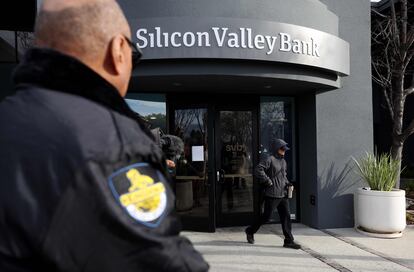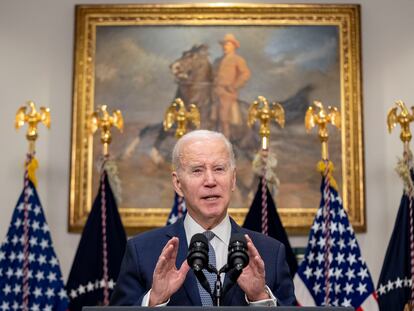Silicon Valley Bank collapse: What you need to know
What’s happening is eerily reminiscent of the financial meltdown that began with the bursting of the housing bubble 15 years ago. Yet the initial pace this time around seems even faster

Two large banks that cater to the tech industry have collapsed after a bank run, government agencies are taking emergency measures to backstop the financial system, and President Joe Biden is reassuring Americans that the money they have in banks is safe. It’s all eerily reminiscent of the financial meltdown that began with the bursting of the housing bubble 15 years ago. Yet the initial pace this time around seems even faster.
Over the last three days, the US seized the two financial institutions after a bank run on Silicon Valley Bank, based in Santa Clara, California. It was the largest bank failure since Washington Mutual went under in 2008.
How did we get here? And will the steps the government unveiled over the weekend be enough? Here are some questions and answers about what has happened and why it matters:
Why did Silicon Valley Bank fail?
Silicon Valley Bank had already been hit hard by a rough patch for technology companies in recent months and the Federal Reserve’s aggressive plan to increase interest rates to combat inflation compounded its problems.
The bank held billions of dollars worth of Treasuries and other bonds, which is typical for most banks as they are considered safe investments. However, the value of previously issued bonds has begun to fall because they pay lower interest rates than comparable bonds issued in today’s higher interest rate environment.
That’s usually not an issue either because bonds are considered long term investments and banks are not required to book declining values until they are sold. Such bonds are not sold for a loss unless there is an emergency and the bank needs cash.
Silicon Valley, the bank that collapsed Friday, had an emergency. Its customers were largely startups and other tech-centric companies that needed more cash over the past year, so they began withdrawing their deposits. That forced the bank to sell a chunk of its bonds at a steep loss, and the pace of those withdrawals accelerated as word spread, effectively rendering Silicon Valley Bank insolvent.
What did the government do Sunday?
The Federal Reserve, the US Treasury Department, and Federal Deposit Insurance Corporation decided to guarantee all deposits at Silicon Valley Bank, as well as at New York’s Signature Bank, which was seized on Sunday. Critically, they agreed to guarantee all deposits, above and beyond the limit on insured deposits of $250,000.
Many of Silicon Valley’s startup tech customers and venture capitalists had far more than $250,000 at the bank. As a result, as much as 90% of Silicon Valley’s deposits were uninsured. Without the government’s decision to backstop them all, many companies would have lost funds needed to meet payroll, pay bills, and keep the lights on.
The goal of the expanded guarantees is to avert bank runs – where customers rush to remove their money – by establishing the Fed’s commitment to protecting the deposits of businesses and individuals and calming nerves after a harrowing few days.
Also late Sunday, the Federal Reserve initiated a broad emergency lending program intended to shore up confidence in the nation’s financial system.
Banks will be allowed to borrow money straight from the Fed in order to cover any potential rush of customer withdrawals without being forced into the type of money-losing bond sales that would threaten their financial stability. Such fire sales are what caused Silicon Valley Bank’s collapse.
If all works as planned, the emergency lending program may not actually have to lend much money. Rather, it will reassure the public that the Fed will cover their deposits and that it is willing to lend big to do so. There is no cap on the amount that banks can borrow, other than their ability to provide collateral.
How is the program intended to work?
Unlike its more byzantine efforts to rescue the banking system during the financial crisis of 2007-08, the Fed’s approach this time is relatively straightforward. It has set up a new lending facility with the bureaucratic moniker, “Bank Term Funding Program.”
The program will provide loans to banks, credit unions, and other financial institutions for up to a year. The banks are being asked to post Treasuries and other government-backed bonds as collateral.
The Fed is being generous in its terms: It will charge a relatively low interest rate – just 0.1 percentage points higher than market rates – and it will lend against the face value of the bonds, rather than the market value. Lending against the face value of bonds is a key provision that will allow banks to borrow more money because the value of those bonds, at least on paper, has fallen as interest rates have moved higher.
As of the end of last year US banks held Treasuries and other securities with about $620 billion of unrealized losses, according to the FDIC. That means they would take huge losses if forced to sell those securities to cover a rush of withdrawals.
How did the banks end up with such a huge loss?
Ironically, a big chunk of that $620 billion in unrealized losses can be tied to the Federal Reserve’s own interest-rate policies over the past year.
In its fight to cool the economy and bring down inflation, the Fed has rapidly pushed up its benchmark interest rate from nearly zero to about 4.6%. That has indirectly lifted the yield, or interest paid, on a range of government bonds, particularly two-year Treasuries, which topped 5% until the end of last week.
When new bonds arrive with higher interest rates, it makes existing bonds with lower yields much less valuable if they must be sold. Banks are not forced to recognize such losses on their books until they sell those assets, which Silicon Valley was forced to do.
How important are the government guarantees?
They’re very important. Legally, the FDIC is required to pursue the cheapest route when winding down a bank. In the case of Silicon Valley or Signature, that would have meant sticking to rules on the books, meaning that only the first $250,000 in depositors’ accounts would be covered.
Going beyond the $250,000 cap required a decision that the failure of the two banks posed a “systemic risk.” The Fed’s six-member board unanimously reached that conclusion. The FDIC and the Treasury Secretary went along with the decision as well.
Will these programs spend taxpayer money?
The US. says that guaranteeing the deposits won’t require any taxpayer funds. Instead, any losses from the FDIC’s insurance fund would be replenished by a levying an additional fee on banks.
Yet Krishna Guha, an analyst with the investment bank Evercore ISI, said that political opponents will argue that the higher FDIC fees will “ultimately fall on small banks and Main Street business.” That, in theory, could cost consumers and businesses in the long run.
Will it all work?
Guha and other analysts say that the government’s response is expansive and should stabilize the banking system, though share prices for medium-sized banks, similar to Silicon Valley and Signature, plunged Monday.
“We think the double-barreled bazooka should be enough to quell potential runs at other regional banks and restore relative stability in the days ahead,” Guha wrote in a note to clients.
Paul Ashworth, an economist at Capital Economics, said the Fed’s lending program means banks should be able to “ride out the storm.”
“These are strong moves,” he said.
Yet Ashworth also added a note of caution: “Rationally, this should be enough to stop any contagion from spreading and taking down more banks... but contagion has always been more about irrational fear, so we would stress that there is no guarantee this will work.”
Sign up for our weekly newsletter to get more English-language news coverage from EL PAÍS USA Edition
Tu suscripción se está usando en otro dispositivo
¿Quieres añadir otro usuario a tu suscripción?
Si continúas leyendo en este dispositivo, no se podrá leer en el otro.
FlechaTu suscripción se está usando en otro dispositivo y solo puedes acceder a EL PAÍS desde un dispositivo a la vez.
Si quieres compartir tu cuenta, cambia tu suscripción a la modalidad Premium, así podrás añadir otro usuario. Cada uno accederá con su propia cuenta de email, lo que os permitirá personalizar vuestra experiencia en EL PAÍS.
¿Tienes una suscripción de empresa? Accede aquí para contratar más cuentas.
En el caso de no saber quién está usando tu cuenta, te recomendamos cambiar tu contraseña aquí.
Si decides continuar compartiendo tu cuenta, este mensaje se mostrará en tu dispositivo y en el de la otra persona que está usando tu cuenta de forma indefinida, afectando a tu experiencia de lectura. Puedes consultar aquí los términos y condiciones de la suscripción digital.
More information
Archived In
Últimas noticias
Most viewed
- Reinhard Genzel, Nobel laureate in physics: ‘One-minute videos will never give you the truth’
- Oona Chaplin: ‘I told James Cameron that I was living in a treehouse and starting a permaculture project with a friend’
- Pablo Escobar’s hippos: A serious environmental problem, 40 years on
- Why we lost the habit of sleeping in two segments and how that changed our sense of time
- The fall of a prolific science journal exposes the billion-dollar profits of scientific publishing










































